Video: Mysterious explosion scares inhabitants of Pernambuco's backlands A resident of one of the municipalities recorded a video showing damage to the roof of his sister's house and shows a large stone that led people to comment that they think they are shrapnel from the fall of a #meteoro Brazil
You are using an out of date browser. It may not display this or other websites correctly.
You should upgrade or use an alternative browser.
You should upgrade or use an alternative browser.
Near-Earth objects and close calls
- Thread starter Gawan
- Start date
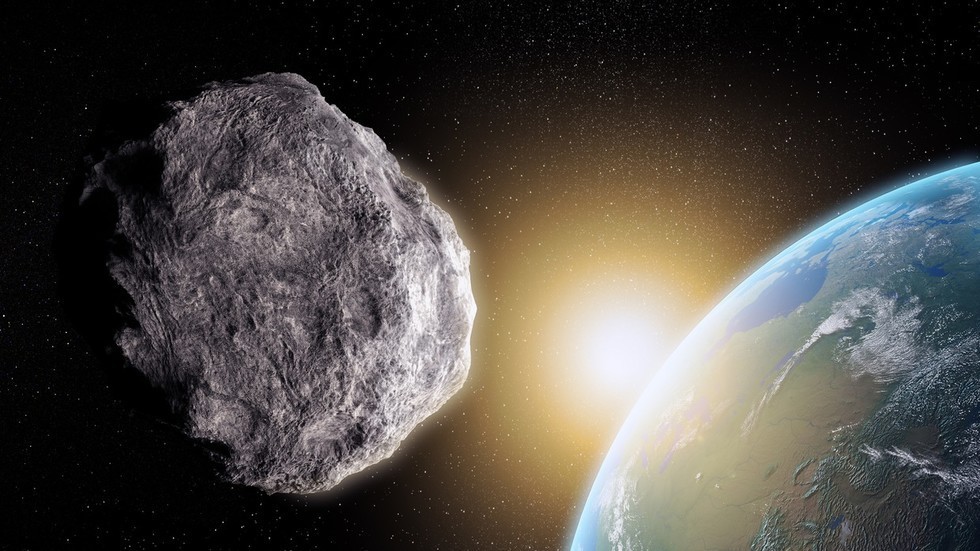
Newly-detected asteroid put on RISK LIST as calculations predict it could hit Earth
A freshly detected asteroid has been put straight onto the European Space Agency’s ‘risk list’ as calculations forecast that it could smash into Earth in 10 years.
A freshly detected asteroid has been put straight onto the European Space Agency’s ‘risk list’ as calculations forecast that it could smash into Earth in 10 years.
The agency detected the space rock this week and immediately added it to the list of potentially hazardous near-Earth objects, as calculations predict that it may hit our planet on August 31, 2029.
The data indicates that the object, known as 2020 PG6, will be traveling at an average speed of over 46,000kph as it races towards Earth. Thankfully, if the asteroid does stray into Earth’s path, it’s unlikely to cause a significant amount of damage as it only measures about 14 meters in diameter.
However, the object is a similar size to the Chelyabinsk meteor which exploded above Russia in February 2013. The comet was just 18 meters in diameter, but was still sizable enough to cause significant localized damage to thousands of buildings in the area.
Scientific investigations into the dramatic explosion found that the energy released by the blast was equivalent to about 30 atomic bombs.
The space agency says that the odds of 2020 PG6 hitting Earth in 2029 are one out of 416, making it one of the asteroids with the highest chances of colliding with Earth on the risk list.
Astronomers will learn more about the newly detected asteroid when it travels past our planet on September 2. During the upcoming flyby, the space rock will come no closer than around 1.4 million miles from Earth so there’s no reason for alarm.
D
Deleted member 4737
Guest
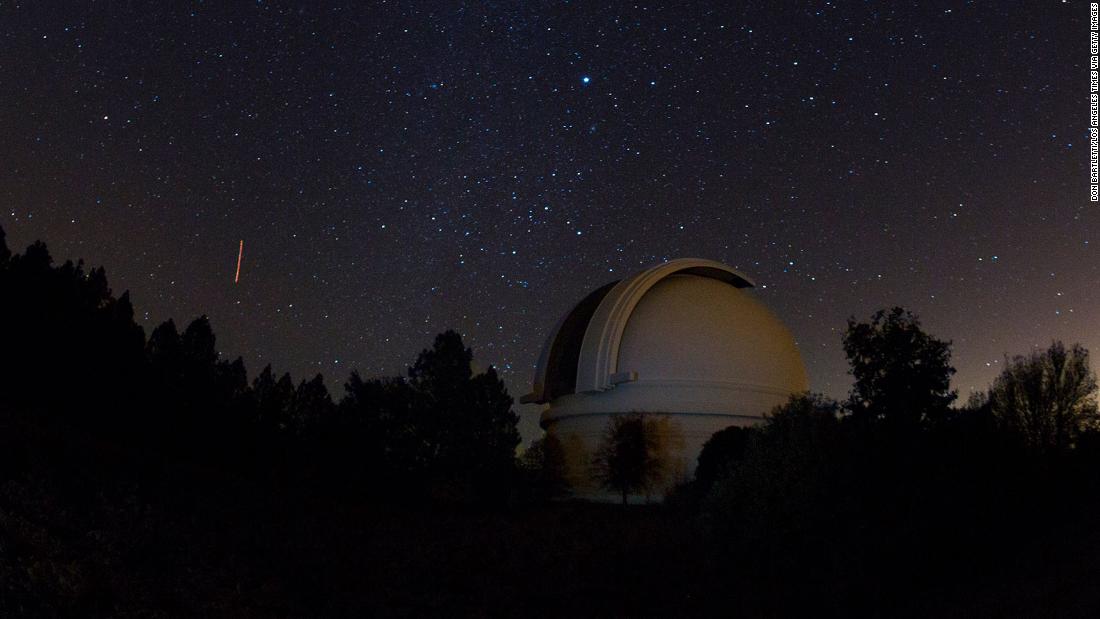
Oh, great: NASA says an asteroid is headed our way right before Election Day
Well, 2020 just keeps getting better all the time.
Possible incoming in November? It must be Trump's fault...
they keep coming our way.
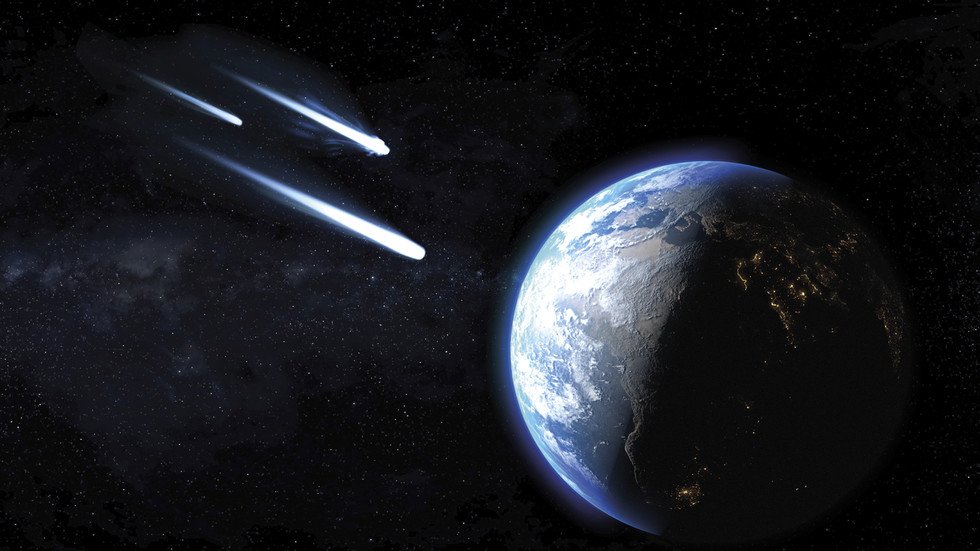
 www.rt.com
www.rt.com
The near-constant bombardment of space rocks buzzing our planet continues, with planetary defenses alerted to a trio of asteroids measuring over 25 meters in diameter en route to Earth’s backyard this week.
To kick things off on Monday, not one but two space rocks over 25 meters (82 feet) in diameter will fly past, both of which were detected just this month, leaving little time and space for error in calculating their trajectories.
Asteroid 2020 PP3, 34 meters wide, will pass us by at a distance of 6.1 million kilometers (3.7 million miles), having only been spotted 13 days ago. It will be followed shortly afterwards by 2020 PJ6, 26 meters wide, at a distance of 5.3 million kilometers, which was spotted four days later on August 15.
Next up, on Wednesday, asteroid 2020 FF3, measuring 25 meters in diameter will come far closer, though maintaining a safe distance of 2.4 million kilometers. This space rock was only spotted on August 14.
Punctuating the mid week are two smaller asteroids, 2016 AH164 (3.9 meters) and 2020 QQ2 (15 meters), which will pass at a distance of six million and 3.2 million kilometers on Wednesday and Thursday respectively.
o put the danger in context, the Chelyabinsk meteor which exploded above Russia in February 2013 was just 18 meters in diameter, proving that it doesn't take much for a meteorite or asteroid to cause a vast amount of destruction.
Meanwhile, the recently-discovered asteroid 2020 PG6 is expected to hit the Earth on August 31, 2029, and measures 14 meters in diameter, highlighting once again the need for humanity to remain vigilant lest we be caught off guard and face a catastrophic impact event.
Meanwhile, another asteroid, known as 2018VP1, stole all the headlines in the past few days having been billed as the “election day asteroid,” as it is estimated to come within 4,994.76 kilometers of Earth on November 2, 2020.
NASA was extremely quick to respond to the breathless headlines, clearly stating that, though there is a very slight chance it'll “hit Earth” on November 2 2020, the day before the US presidential election, 2018VP1 is only two meters in diameter so will likely burn up in the Earth's atmosphere if it does stray too close.

Cutting it close! THREE asteroids inbound this week were only spotted THIS MONTH, NASA reveals
The near-constant bombardment of space rocks buzzing our planet continues, with planetary defenses alerted to a trio of asteroids measuring over 25 meters in diameter en route to Earth’s backyard this week.
The near-constant bombardment of space rocks buzzing our planet continues, with planetary defenses alerted to a trio of asteroids measuring over 25 meters in diameter en route to Earth’s backyard this week.
To kick things off on Monday, not one but two space rocks over 25 meters (82 feet) in diameter will fly past, both of which were detected just this month, leaving little time and space for error in calculating their trajectories.
Asteroid 2020 PP3, 34 meters wide, will pass us by at a distance of 6.1 million kilometers (3.7 million miles), having only been spotted 13 days ago. It will be followed shortly afterwards by 2020 PJ6, 26 meters wide, at a distance of 5.3 million kilometers, which was spotted four days later on August 15.
Next up, on Wednesday, asteroid 2020 FF3, measuring 25 meters in diameter will come far closer, though maintaining a safe distance of 2.4 million kilometers. This space rock was only spotted on August 14.
Punctuating the mid week are two smaller asteroids, 2016 AH164 (3.9 meters) and 2020 QQ2 (15 meters), which will pass at a distance of six million and 3.2 million kilometers on Wednesday and Thursday respectively.
o put the danger in context, the Chelyabinsk meteor which exploded above Russia in February 2013 was just 18 meters in diameter, proving that it doesn't take much for a meteorite or asteroid to cause a vast amount of destruction.
Meanwhile, the recently-discovered asteroid 2020 PG6 is expected to hit the Earth on August 31, 2029, and measures 14 meters in diameter, highlighting once again the need for humanity to remain vigilant lest we be caught off guard and face a catastrophic impact event.
Meanwhile, another asteroid, known as 2018VP1, stole all the headlines in the past few days having been billed as the “election day asteroid,” as it is estimated to come within 4,994.76 kilometers of Earth on November 2, 2020.
NASA was extremely quick to respond to the breathless headlines, clearly stating that, though there is a very slight chance it'll “hit Earth” on November 2 2020, the day before the US presidential election, 2018VP1 is only two meters in diameter so will likely burn up in the Earth's atmosphere if it does stray too close.
The fireball on August 21, 2020 was in the field of view of the meteor observation network that we are carrying out with citizens, and we were able to capture it with many cameras. At the meteorological subcommittee of the Astronomical Observatory of the Hiratsuka City Museum, we are installing our own video camera on the balcony of each home to find the hometown of the meteor.
Second Tweet
As a result of the orbit analysis, it is known that the fireball this time comes from the asteroid belt and has a different orbit from the Narashino meteorite. The path and trajectory of the fireball. If it is a meteor, it may have fallen to the sea or the Boso Peninsula. https://youtu.be/8yUqS1EXR-0
August 21, 2020 - UArizona Scientist Plays Role in Ongoing Mission to Bring Asteroid Sample Back to Earth - Fox 10
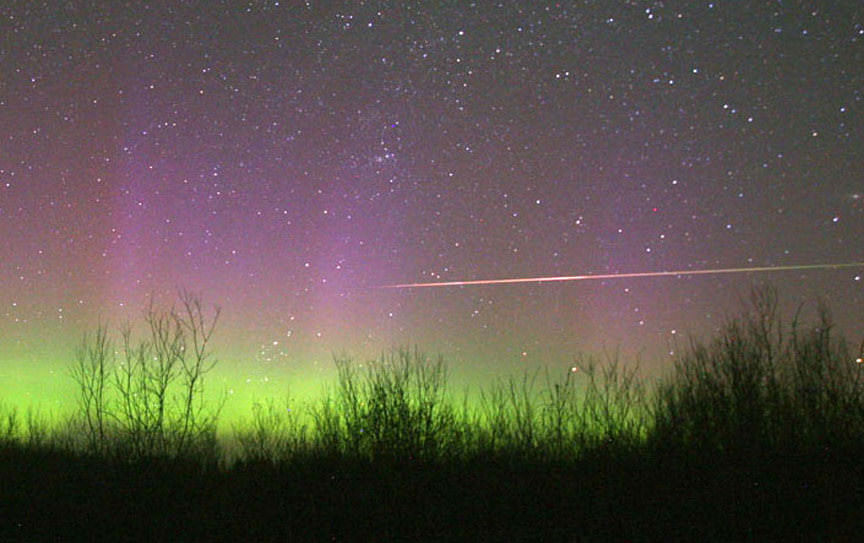
 www.universetoday.com
Posted on August 24, 2020 by Nancy Atkinson
www.universetoday.com
Posted on August 24, 2020 by Nancy Atkinson
Completely Harmless Asteroid Almost Certainly Won’t Hit Earth Just Before the US Election
In a year of devastating wildfires, destructive derechos, early and active hurricanes, widespread social unrest, contentious politics and more — all amid an unprecedented global pandemic — it might seem fitting that ‘asteroid impact’ would be added to the 2020 bingo card.
While weekend headlines buzzed over the prediction of an asteroid hitting Earth on November 2, just one day before the US presidential election, in reality, this is one thing we don’t have to worry about.
“Asteroid 2018VP1 is very small, approx. 6.5 feet, and poses no threat to Earth! It currently has a 0.41% chance of entering our planet’s atmosphere, but if it did, it would disintegrate due to its extremely small size,” NASA Asteroid Watch posted reassuringly on Twitter.
To be clear, that’s less than half a percent chance.
“The likelihood of this asteroid hitting Earth is vanishingly small,” planetary scientist Allessondra Springmann told Universe Today, “plus, this rock is tiny. It’s about the size of your couch. In the unlikely event it would hit our atmosphere, it would break apart and disintegrate. If anything hit the ground, it would be extremely small; a fleck of rock or speck of sand.”
NASA’s Center for Near Earth Object Studies and the International Asteroid Warning Network have observatories around the world scanning the skies for potentially hazardous space rocks. Asteroid 2018VP1 was discovered in 2018, and has been observed 21 times over nearly 13 days. Astronomers have tracked the object enough to be extremely confident in the knowledge of where the object will be in the future. On November 2, 2020, NASA predicts this asteroid will be more than 260,000 miles (420,000 kilometers) away, which is about the distance of the Moon from Earth.
“Asteroid 2018VP1 is super tiny, but it shows how excellent our tracking and detection capabilities are in finding objects of this size,” Springmann said.
By chance, another asteroid will make a close approach on the US’s Election Day itself, Nov. 3. Asteroid 2020 HF4 is about 26 to 60 feet (8 to 18 meters) across, but will remain much farther away, about 16 times the distance of the moon, according to NASA.
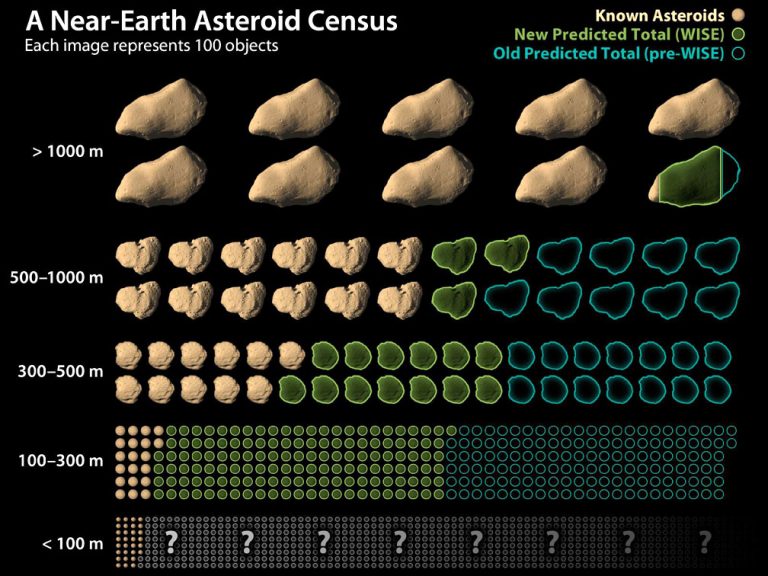
This chart shows how data from NASA’s Wide-field Infrared Survey Explorer, or WISE, has led to revisions in the estimated population of near-Earth asteroids. Credit: NASA/JPL-Caltech
Last week, an SUV-size asteroid set the record for coming closer to Earth than any other known Near Earth Asteroid (NEA): 2020 QG passed 1,830 miles (2,950 kilometers) above the southern Indian Ocean on Sunday, Aug. 16 at 12:08 a.m. EDT (Saturday, Aug. 15 at 9:08 p.m. PDT). Estimated at 10 to 20 feet (3 to 6 meters) across, asteroid 2020 QG is very small by asteroid standards: If it had actually been on an impact trajectory, it would likely have become a fireball as it broke up in Earth’s atmosphere, which happens several times a year.
NASA says that every day, Earth is bombarded with more than 100 tons of dust and sand-sized particles. Space rocks smaller than about 25 meters (about 82 feet) will most likely burn up as they enter the Earth’s atmosphere and cause little or no damage.
NASA projects that every 2,000 years or so, a meteoroid the size of a football field hits Earth and would cause significant damage to a specific area. Only once every few million years, an object large enough to threaten Earth’s civilization comes along.
“Asteroid 2018VP1 is a ‘large boulder the size of a small boulder’ as the meme goes,” Springmann said, “so this asteroid is not going to ruin anyone’s day.”Lead image courtesy of Bob King.
The Minor Planet Center
Running Tallies
Near-Earth Objects Discovered
The International Asteroid Warning Network (IAWN)
IAWN was established (2013) as a result of the UN-endorsed recommendations for an international response to a potential NEO impact threat, to create an international group of organizations involved in detecting, tracking, and characterizing NEOs. The IAWN is tasked with developing a strategy using well-defined communication plans and protocols to assist Governments in the analysis of asteroid impact consequences and in the planning of mitigation responses. Currently, IAWN includes members from Europe, Asia, South and North America.
Northolt Branch Obs @NBObservatories
Apollo-type asteroid 2020 PY2. Diameter 13-30 metres. First observed at Pan-STARRS 1. Close approach last night: Distance 350,000 km. The asteroid was visible at mag +15, moving at 550 arc-minutes per hour. #SpotTheAsteroid
@AsteroidDay @NEOShieldTeam @QHYCCD @RoyalAstroSoc
Second Tweet
As a result of the orbit analysis, it is known that the fireball this time comes from the asteroid belt and has a different orbit from the Narashino meteorite. The path and trajectory of the fireball. If it is a meteor, it may have fallen to the sea or the Boso Peninsula. https://youtu.be/8yUqS1EXR-0
August 21, 2020 - UArizona Scientist Plays Role in Ongoing Mission to Bring Asteroid Sample Back to Earth - Fox 10

Completely Harmless Asteroid Almost Certainly Won't Hit Earth Just Before the US Election
In a year of devastating wildfires, destructive derechos, early and active hurricanes, widespread social unrest, contentious politics and more — all amid an unprecedented global pandemic — it might seem fitting that ‘asteroid impact’ would be added to the 2020 bingo card. While weekend headlines...
 www.universetoday.com
www.universetoday.com
Completely Harmless Asteroid Almost Certainly Won’t Hit Earth Just Before the US Election
In a year of devastating wildfires, destructive derechos, early and active hurricanes, widespread social unrest, contentious politics and more — all amid an unprecedented global pandemic — it might seem fitting that ‘asteroid impact’ would be added to the 2020 bingo card.
While weekend headlines buzzed over the prediction of an asteroid hitting Earth on November 2, just one day before the US presidential election, in reality, this is one thing we don’t have to worry about.
“Asteroid 2018VP1 is very small, approx. 6.5 feet, and poses no threat to Earth! It currently has a 0.41% chance of entering our planet’s atmosphere, but if it did, it would disintegrate due to its extremely small size,” NASA Asteroid Watch posted reassuringly on Twitter.
To be clear, that’s less than half a percent chance.
“The likelihood of this asteroid hitting Earth is vanishingly small,” planetary scientist Allessondra Springmann told Universe Today, “plus, this rock is tiny. It’s about the size of your couch. In the unlikely event it would hit our atmosphere, it would break apart and disintegrate. If anything hit the ground, it would be extremely small; a fleck of rock or speck of sand.”
NASA’s Center for Near Earth Object Studies and the International Asteroid Warning Network have observatories around the world scanning the skies for potentially hazardous space rocks. Asteroid 2018VP1 was discovered in 2018, and has been observed 21 times over nearly 13 days. Astronomers have tracked the object enough to be extremely confident in the knowledge of where the object will be in the future. On November 2, 2020, NASA predicts this asteroid will be more than 260,000 miles (420,000 kilometers) away, which is about the distance of the Moon from Earth.
“Asteroid 2018VP1 is super tiny, but it shows how excellent our tracking and detection capabilities are in finding objects of this size,” Springmann said.
By chance, another asteroid will make a close approach on the US’s Election Day itself, Nov. 3. Asteroid 2020 HF4 is about 26 to 60 feet (8 to 18 meters) across, but will remain much farther away, about 16 times the distance of the moon, according to NASA.

This chart shows how data from NASA’s Wide-field Infrared Survey Explorer, or WISE, has led to revisions in the estimated population of near-Earth asteroids. Credit: NASA/JPL-Caltech
Last week, an SUV-size asteroid set the record for coming closer to Earth than any other known Near Earth Asteroid (NEA): 2020 QG passed 1,830 miles (2,950 kilometers) above the southern Indian Ocean on Sunday, Aug. 16 at 12:08 a.m. EDT (Saturday, Aug. 15 at 9:08 p.m. PDT). Estimated at 10 to 20 feet (3 to 6 meters) across, asteroid 2020 QG is very small by asteroid standards: If it had actually been on an impact trajectory, it would likely have become a fireball as it broke up in Earth’s atmosphere, which happens several times a year.
NASA says that every day, Earth is bombarded with more than 100 tons of dust and sand-sized particles. Space rocks smaller than about 25 meters (about 82 feet) will most likely burn up as they enter the Earth’s atmosphere and cause little or no damage.
NASA projects that every 2,000 years or so, a meteoroid the size of a football field hits Earth and would cause significant damage to a specific area. Only once every few million years, an object large enough to threaten Earth’s civilization comes along.
“Asteroid 2018VP1 is a ‘large boulder the size of a small boulder’ as the meme goes,” Springmann said, “so this asteroid is not going to ruin anyone’s day.”Lead image courtesy of Bob King.
The Minor Planet Center
Running Tallies
Near-Earth Objects Discovered
| THIS MONTH: | 213 |
| THIS YEAR: | 1709 |
| LAST YEAR: | 2436 |
| ALL TIME: | 23553 |
The International Asteroid Warning Network (IAWN)
IAWN was established (2013) as a result of the UN-endorsed recommendations for an international response to a potential NEO impact threat, to create an international group of organizations involved in detecting, tracking, and characterizing NEOs. The IAWN is tasked with developing a strategy using well-defined communication plans and protocols to assist Governments in the analysis of asteroid impact consequences and in the planning of mitigation responses. Currently, IAWN includes members from Europe, Asia, South and North America.
Northolt Branch Obs @NBObservatories
Apollo-type asteroid 2020 PY2. Diameter 13-30 metres. First observed at Pan-STARRS 1. Close approach last night: Distance 350,000 km. The asteroid was visible at mag +15, moving at 550 arc-minutes per hour. #SpotTheAsteroid
@AsteroidDay @NEOShieldTeam @QHYCCD @RoyalAstroSoc
Coming in hot and heavy!
It is a report that is 5 days late, but the Yomiuri Shimbun is a big article on the asteroid Shizuka Takanari with a photo! What I have in the photo is the asteroid naming amount. It was made in celebration by the Toa Astronomical Society who recommended it. It is displayed on the wall of my house (the certificate on the right is the Hale Prize). Thanks to everyone! !
 theskylive.com
theskylive.com
It is a report that is 5 days late, but the Yomiuri Shimbun is a big article on the asteroid Shizuka Takanari with a photo! What I have in the photo is the asteroid naming amount. It was made in celebration by the Toa Astronomical Society who recommended it. It is displayed on the wall of my house (the certificate on the right is the Hale Prize). Thanks to everyone! !
Where is Comet C/2020 Q1 (Borisov)? All you need to know to find Comet C/2020 Q1 (Borisov) in the sky.
All most complete and up to date resources needed to find Comet C/2020 Q1 (Borisov) in the sky
Last edited:
Fireballs, sighting information one after another in the Kanto region etc. (TBS system (JNN)) #Yahooニュース https://news.yahoo.co.jp/articles/16aacc7fefd0f600cdebb612f633a2e612d1109c This is a contrail illuminated by the sunset. The fireball flows in about 10 seconds at the longest and cannot be seen in minutes. In the evening, if you see long yellow or orange glows in the west sky, suspect contrails.
Bright meteor during the night crossed the sky and was recorded by Satellite antenna monitoring stations in SP and MG. #chuvademeteoros#radiante#meteor#céu#exoss
Bright meteor during the night crossed the sky and was recorded by Satellite antenna monitoring stations in SP and MG. #chuvademeteoros#radiante#meteor#céu#exoss
Fun Facts...2011 ES4 A very small Apollo-class Asteroid.
Largest Asteroid End Of The Month Report August 2020
Aug 28, 2020 / 8:26
Here are the largest asteroids headed towards Earth. The month is almost over and it's been very interesting. A lot of asteroids have been reported and a lot more to come. The size of these asteroids are very interesting and scare the socks out of me. My imagination goes wide I keep on wondering what else is out there, I'm sure a lot can relate. Join us next time as we do a live countdown of asteroid (2011 ES4)
2011 ES4
Asteroid (2011 ES4) Closest Approach Will Be Less Than 1 LD. Not a big asteroid but close enough to get some media attention. But no fear, this asteroid will not hit Earth, it will be 44,000 miles away when it's closest approach occurs. Let us know if you have any questions.
 www.spacereference.org
Key Facts
www.spacereference.org
Key Facts
8/30/2020, 2:00:00 PM ⧉
Sky Map
The position of 2011 ES4 is indicated by a ◯ pink circle. Note that the object may not be in your current field of view. Use the controls below to adjust position, location, and time.
Location°° Date/time Horizon marker Planets, Sun & Moon
Size Rendering and Map Comparison
Asteroid 465824 (2010 FR) Potentially Hazardous Object Passing Earth On Read A Book Day
Aug 30, 2020
Asteroid 465824 (2010 FR) Potentially Hazardous Asteroid Passing Earth On Read A Book Day, September 6, 2020. It is classified as a Potentially Hazardous Asteroid and expected not to hit Earth On. It measures around 900 Feet and it will be close to 4.6 Million miles away during its close approach. So we are safe.
Asteroid (2020 PW3) 500 Feet Object - Close Approach Countdown
Premiered 16 hours ago
Watch Asteroid (2020 PW3) 500 Feet Object - Close Approach Countdown(2020 PW3) Will Be Far From Earth During Close Approach, over 15 million miles away. The asteroid stands a little under 500 feet so an impact if not expected. We are safe. Upcoming Asteroids Watch List(2018 VP1) Impact Risk Sentry -
Asteroid (2020 PW3) 500 Feet Object - Close Approach Countdown
Asteroid Occultation Updates
Updated: 2020 Aug 29, 17:25 UT
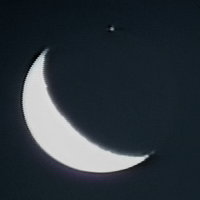
 en.wikipedia.org
Examples
en.wikipedia.org
Examples
According to the 1998 European Asteroidal Occultation Results from Euraster, 39 Laetitia was observed by over 38 observatories in one occultation on 3 March 1998, which resulted in many chords being determined.[8] The star Regulus was occulted by the asteroid 163 Erigone in the early morning of 20 March 2014.[9] This was the brightest occultation of an asteroid ever predicted to occur over a populated area. As the main belt asteroid passed in front of the star its 100 km (60 mi) shadow swept across Nassau and Suffolk counties, all of New York City and the Hudson River Valley, with the center of the shadow path following a line roughly connecting New York City, White Plains, Newburgh, Oneonta, Rome and Pulaski before crossing into Canada near Belleville and North Bay, Ontario.[9][10] Bad weather obscured the occultation.[11]
Watch Asteroid (2011 ES4) Journey Close To Earth -
6:12 AM · Aug 28, 2020 Asteroid Station
Simulated Countdown Live Chat https://youtu.be/8YNExbDAlho via @YouTube
Asteroids and Comets Compiled data & simulations for 962,651 celestial objects
SpaceReference.org.
Largest Asteroid End Of The Month Report August 2020
Aug 28, 2020 / 8:26
Here are the largest asteroids headed towards Earth. The month is almost over and it's been very interesting. A lot of asteroids have been reported and a lot more to come. The size of these asteroids are very interesting and scare the socks out of me. My imagination goes wide I keep on wondering what else is out there, I'm sure a lot can relate. Join us next time as we do a live countdown of asteroid (2011 ES4)
2011 ES4
Asteroid 2011 ES4 | Space Reference
- Categorized as a Apollo-class Asteroid
- Comparable in size to the U.S. Capitol building
- Will pass within 22,653,614 km of Earth in 2019
- Classified as a Near Earth Asteroid (NEA)
- Not a Potentially Hazardous Object
- See orbit simulation
8/30/2020, 2:00:00 PM ⧉
Sky Map
The position of 2011 ES4 is indicated by a ◯ pink circle. Note that the object may not be in your current field of view. Use the controls below to adjust position, location, and time.
Location°° Date/time Horizon marker Planets, Sun & Moon
Size Rendering and Map Comparison
Asteroid 465824 (2010 FR) Potentially Hazardous Object Passing Earth On Read A Book Day
Aug 30, 2020
Asteroid 465824 (2010 FR) Potentially Hazardous Asteroid Passing Earth On Read A Book Day, September 6, 2020. It is classified as a Potentially Hazardous Asteroid and expected not to hit Earth On. It measures around 900 Feet and it will be close to 4.6 Million miles away during its close approach. So we are safe.
Asteroid (2020 PW3) 500 Feet Object - Close Approach Countdown
Premiered 16 hours ago
Watch Asteroid (2020 PW3) 500 Feet Object - Close Approach Countdown(2020 PW3) Will Be Far From Earth During Close Approach, over 15 million miles away. The asteroid stands a little under 500 feet so an impact if not expected. We are safe. Upcoming Asteroids Watch List(2018 VP1) Impact Risk Sentry -
Asteroid (2020 PW3) 500 Feet Object - Close Approach Countdown
Asteroid Occultation Updates
Updated: 2020 Aug 29, 17:25 UT

Occultation - Wikipedia
According to the 1998 European Asteroidal Occultation Results from Euraster, 39 Laetitia was observed by over 38 observatories in one occultation on 3 March 1998, which resulted in many chords being determined.[8] The star Regulus was occulted by the asteroid 163 Erigone in the early morning of 20 March 2014.[9] This was the brightest occultation of an asteroid ever predicted to occur over a populated area. As the main belt asteroid passed in front of the star its 100 km (60 mi) shadow swept across Nassau and Suffolk counties, all of New York City and the Hudson River Valley, with the center of the shadow path following a line roughly connecting New York City, White Plains, Newburgh, Oneonta, Rome and Pulaski before crossing into Canada near Belleville and North Bay, Ontario.[9][10] Bad weather obscured the occultation.[11]
Watch Asteroid (2011 ES4) Journey Close To Earth -
6:12 AM · Aug 28, 2020 Asteroid Station
Simulated Countdown Live Chat https://youtu.be/8YNExbDAlho via @YouTube
Asteroids and Comets Compiled data & simulations for 962,651 celestial objects
SpaceReference.org.
In August, 80 asteroids flew past the Earth...
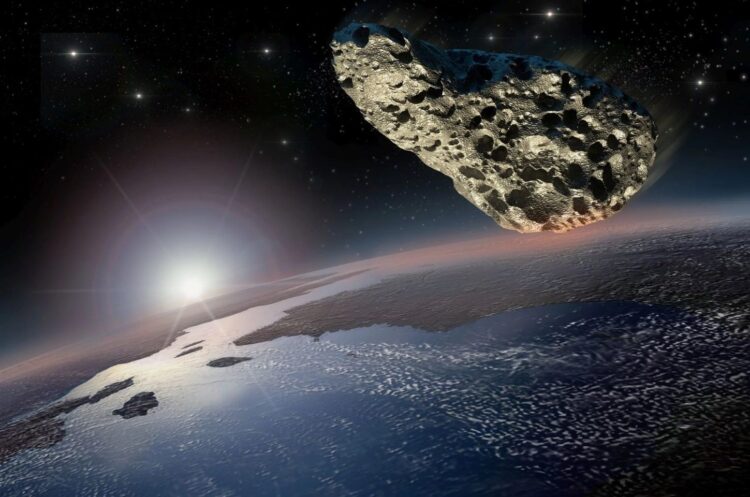
During August, Roskosmos recorded 80 asteroid convergences with the Earth.
One of the asteroids passed the Earth at a distance of eight thousand kilometers, the rest went further. All objects observed by Roskosmos belonged to the group of Apollo, 70 of them were not known before. Another 10 were discovered in 2007-2018.
The Apollo group included asteroids with a trajectory crossing the Earth's orbit.
It was previously reported that NASA had warned of the approaching asteroid with a diameter of 22 to 49 metres, which would travel about 120,000 kilometres from Earth.
At Roscosmos, the danger of collision with this object was called insignificant.
The source: В августе к Земле приблизились 70 неизвестных астероидов

During August, Roskosmos recorded 80 asteroid convergences with the Earth.
One of the asteroids passed the Earth at a distance of eight thousand kilometers, the rest went further. All objects observed by Roskosmos belonged to the group of Apollo, 70 of them were not known before. Another 10 were discovered in 2007-2018.
The Apollo group included asteroids with a trajectory crossing the Earth's orbit.
It was previously reported that NASA had warned of the approaching asteroid with a diameter of 22 to 49 metres, which would travel about 120,000 kilometres from Earth.
At Roscosmos, the danger of collision with this object was called insignificant.
The source: В августе к Земле приблизились 70 неизвестных астероидов
lilies
The Living Force
Comets visible in September 2020 (Multiple Translations)
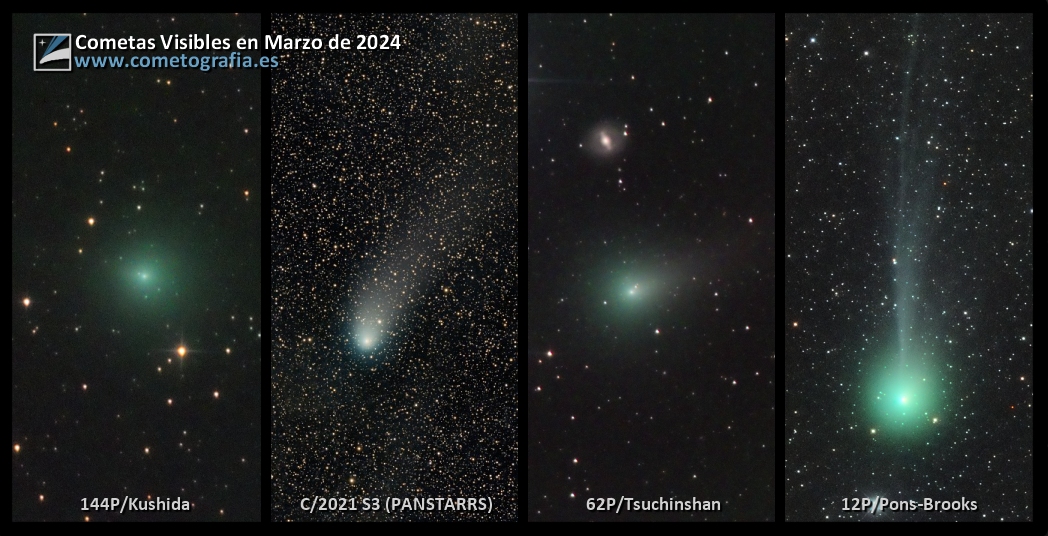
 cometografia.es
Information about comets visible in the sky of September 2020
cometografia.es
Information about comets visible in the sky of September 2020
The famed comet C / 2020 F3 (NEOWISE) receding will no longer be observable with binoculars dropping from magnitude 8.5 to 11. As a couple of interesting comets for the fall enter the scene: 88P / Howell rising to magnitude 9 and the new 'Halley-type' periodic comet C / 2020 M3 (ATLAS) brighter than anticipated and will at least reach magnitude 9.5 this month, both observable with small telescopes; on the other hand, C / 2017 T2 (PANSTARRS) is already very far away at magnitude 12, only observable with large aperture telescopes. Finally, we say goodbye to comets C / 2019 U6 (Lemmon) and 2P / Encke, already very weakened.
Forecast
I have calculated the light curve from an absolute magnitude of 9.6 and a standard activity increase coefficient of n = 4, resulting in a maximum visual brightness of magnitude 8.5 for November 2020 at the limit of its observation through binoculars. Meanwhile, in September the comet will increase in brightness from magnitude 11 to 9.5 so it will be observable through small telescopes.
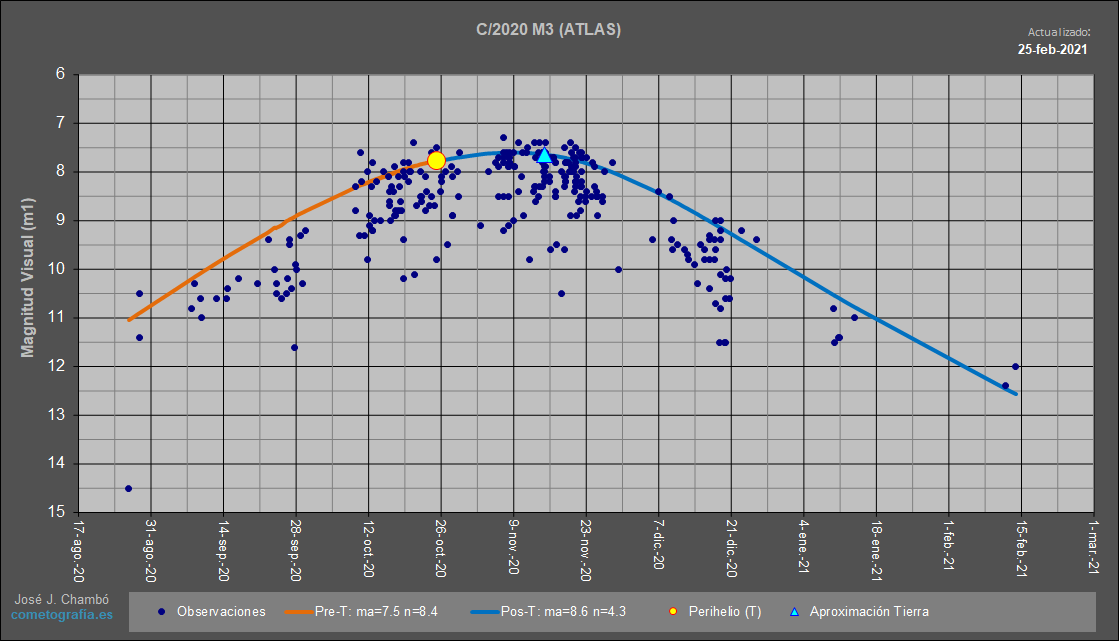
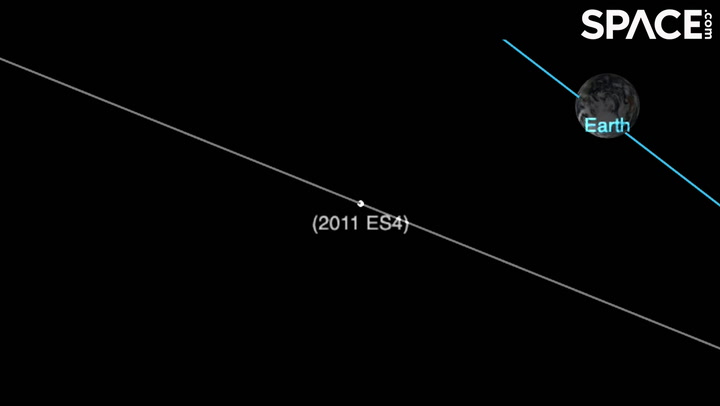
 videos.space.com
videos.space.com

Cometas visibles en Marzo de 2024 - Cometografía
Por fin el cometa 12P/Pons-Brooks se aproxima a su máximo brillo siendo visible con binoculares subiendo de la magnitud 6 a la 5. Con pequeños telescopios podremos observar al C/2021 S3 (PANSTARRS) en su máximo de magnitud 9.5 y a los cometas 62P/Tsuchishan y 144P/Kushida en la magnitud 10 y...
The famed comet C / 2020 F3 (NEOWISE) receding will no longer be observable with binoculars dropping from magnitude 8.5 to 11. As a couple of interesting comets for the fall enter the scene: 88P / Howell rising to magnitude 9 and the new 'Halley-type' periodic comet C / 2020 M3 (ATLAS) brighter than anticipated and will at least reach magnitude 9.5 this month, both observable with small telescopes; on the other hand, C / 2017 T2 (PANSTARRS) is already very far away at magnitude 12, only observable with large aperture telescopes. Finally, we say goodbye to comets C / 2019 U6 (Lemmon) and 2P / Encke, already very weakened.
Forecast
I have calculated the light curve from an absolute magnitude of 9.6 and a standard activity increase coefficient of n = 4, resulting in a maximum visual brightness of magnitude 8.5 for November 2020 at the limit of its observation through binoculars. Meanwhile, in September the comet will increase in brightness from magnitude 11 to 9.5 so it will be observable through small telescopes.


Airplane-size asteroid to fly close to Earth - Orbit animation
Asteroid 2011 ES4 will fly "about 45,000 miles (792,000 football fields) away" from Earth on Sept. 1, 2020, according to NASA. It poses no threat to our planet. Credit: Space.com / orbit animation: NASA/JPL-Caltech / produced & edited by [Steve Spaleta](http://www.twitter.com/stevespaleta)
It sure does seem that there have been a lot of comets over the past few years, and the number increasing, or is it my imagination? I don't remember people talking about comets very much (if at all), during all the years I was growing up.
It sure does seem that there have been a lot of comets over the past few years, and the number increasing, or is it my imagination? I don't remember people talking about comets very much (if at all), during all the years I was growing up.
I agree Laura. I can't recall a year with so many meteorite or meteor impact reports either. Here is the latest from Sputnik International yesterday:
Pennies From Heaven: Meteorites Worth Thousands of Dollars Rain Upon Brazilian Town
The largest chunk of the meteorite, weighing about 40 kilograms, is reportedly worth around $26,000.
Residents of a remote town in northeastern Brazil called Santa Filomena recently received an unexpected bonanza when chunks of a meteorite believed to be 4.6 billion-year-old started falling "like rain" from the sky on 19 August, the Daily Mail reports.
According to the newspaper, the meteorite was a "rare chondrite which dates back to the origins of the Solar System", and whose fragments turned out to be quite valuable, with the biggest chunk, weighing about 40 kilograms, being worth over £20,000 ($26,000) - "the same as 10 years' worth of the average salary in the area".
"The price is getting close to 40 reals (£5.50) per gramme, and it's getting higher. Only a few days ago it was half that", said Edimar da Costa Rodrigues, a 20-year old student who discovered one of the fragments. "Ninety percent of the town's population are farmers. There aren't many shops, nothing that generates jobs. It's a humble place, with people on a low wage. Most people think it's a really good thing. Lots of people have found a rock, and it has come at a time when many really need some money to pay the bills".
As the majority of the biggest rocks were discovered in the vicinity of the Catholic church near the town's main square, it led to "further convincing" the locals that the meteorite was "sent by God", the newspaper adds.
Other reported meteor impacts so far this year include:
- Another meteorite-like object falls from sky in Rajasthan, India (June 2020)
- Investigators confirm meteorite discovery in El Empalme, Ecuador (April 2020)
- Massive explosion leaves giant crater in Akure, Nigeria, dozens of buildings damaged - UPDATE: Expert suspects METEOR IMPACT (March 2020)
- Three fiery meteorites reportedly hit ground in Ghaziabad, Uttar Pradesh, India (March 2020)
- Meteorite hit a factory compound in Alwar, Rajasthan, India (February 2020)
more space rock.
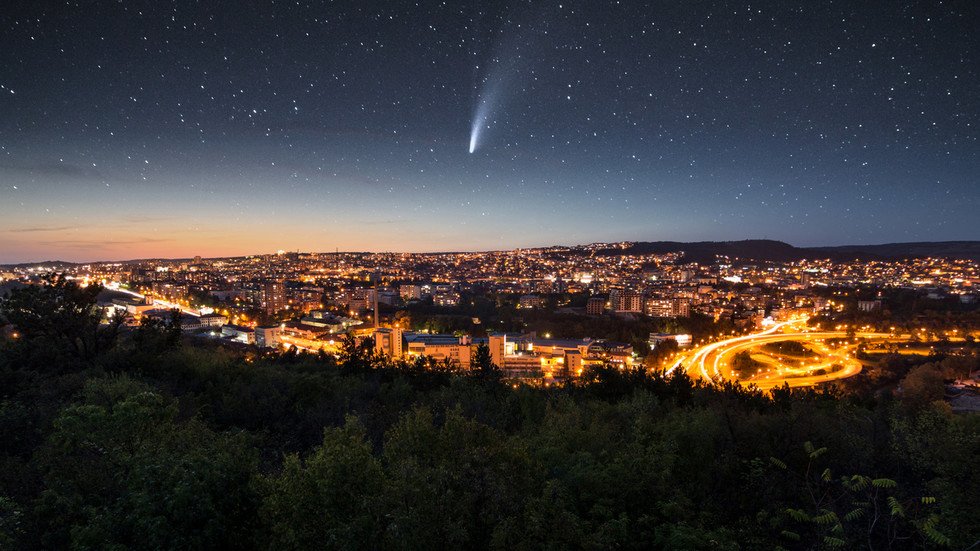
 www.rt.com
www.rt.com
NASA is warning of four asteroids over 20 meters in diameter due to make a close flyby of Earth this week, while the ESA has shared a video showing just how difficult it is for planetary defenses to spot these inbound space rocks.
The first two Near Earth Objects (NEOs), due on Tuesday, were both only spotted in the last month: 2020 PT4, which is 34m in diameter or roughly half the wingspan of a 747, will pass us at a distance of 1.8 million km while the 24m 2020 RJ, roughly three London buses in length, will shoot past at a distance of 1.2 million km.
Later, on September 12, 2020, RM15, which is roughly half the size of the statue of Liberty (43m), will whizz past us at 35,000kph, thankfully far beyond the Moon, at a distance of 5.7 million km.
Bringing up the rear in this latest barrage of space debris on September 13 will be asteroid 2017 US, measuring an even 20m in diameter (roughly three adult giraffes stacked on top of each other) at a distance of 6.6 million km.
In the meantime, the European Space Agency (ESA) has shared somewhat terrifying footage of what our planetary defense officials are working with.
The ESA estimates that we are aware of 95 percent of all objects measuring over one kilometer in diameter in our solar system.
However, that number drops precipitously with smaller objects, with only somewhere in the region of 18,000 of an estimated two million or more objects measuring around the 30-meter mark accounted for according to ESA data.
To show just how difficult it is to spot these smaller objects as they hurtle towards our planet, the ESA shared this video of an object named 2020 OM3, roughly 40m in diameter, which passed us at a distance of 10 million km back in July.

© ESA
In the endlessly looping gif, somewhere amongst the noise and the black splotches, is 2020 OM3 which appears as a faint speck of light, which may explain the frequent alerts of recently-detected, inbound asteroids headed for Earth’s backyard.

NASA warns of 4 inbound asteroids as ESA shares VIDEO showing just how hard they are to spot
NASA is warning of four asteroids over 20 meters in diameter due to make a close flyby of Earth this week, while the ESA has shared a video showing just how difficult it is for planetary defenses to spot these inbound space rocks.
NASA is warning of four asteroids over 20 meters in diameter due to make a close flyby of Earth this week, while the ESA has shared a video showing just how difficult it is for planetary defenses to spot these inbound space rocks.
The first two Near Earth Objects (NEOs), due on Tuesday, were both only spotted in the last month: 2020 PT4, which is 34m in diameter or roughly half the wingspan of a 747, will pass us at a distance of 1.8 million km while the 24m 2020 RJ, roughly three London buses in length, will shoot past at a distance of 1.2 million km.
Later, on September 12, 2020, RM15, which is roughly half the size of the statue of Liberty (43m), will whizz past us at 35,000kph, thankfully far beyond the Moon, at a distance of 5.7 million km.
Bringing up the rear in this latest barrage of space debris on September 13 will be asteroid 2017 US, measuring an even 20m in diameter (roughly three adult giraffes stacked on top of each other) at a distance of 6.6 million km.
In the meantime, the European Space Agency (ESA) has shared somewhat terrifying footage of what our planetary defense officials are working with.
The ESA estimates that we are aware of 95 percent of all objects measuring over one kilometer in diameter in our solar system.
However, that number drops precipitously with smaller objects, with only somewhere in the region of 18,000 of an estimated two million or more objects measuring around the 30-meter mark accounted for according to ESA data.
To show just how difficult it is to spot these smaller objects as they hurtle towards our planet, the ESA shared this video of an object named 2020 OM3, roughly 40m in diameter, which passed us at a distance of 10 million km back in July.

© ESA
In the endlessly looping gif, somewhere amongst the noise and the black splotches, is 2020 OM3 which appears as a faint speck of light, which may explain the frequent alerts of recently-detected, inbound asteroids headed for Earth’s backyard.

